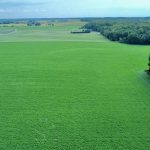SWIFT CURRENT, Sask. – New chickpea growers can make things easier on themselves by choosing the right variety, researcher Yantai Gan told about 200 pulse growers at a workshop in Swift Current.
Because chickpeas are so susceptible to ascochyta blight, Gan said growers should do everything they can to minimize the risk, which includes choosing between fern and unifoliate varieties and desis and kabulis.
“Desi varieties have less disease and produce higher yields than kabuli in general,” Gan said.
However, fern-leaf kabuli varieties have less disease and produce higher yields than unifoliate types.
Read Also

Forecast leans toward cooling trend
July saw below average temperatures, August came in with near to slightly above average temperatures and September built on this warming trend with well above average temperatures for the month.
Large-seeded kabuli varieties are more susceptible to ascochyta, require more intensive care and are better grown by more experienced farmers, he said.
“New growers may be better off with desi varieties first, and fern-leaf varieties.”
Desi varieties available in Saskatchewan are all fern-leaf types: Myles, CDC Anna, CDC Cabri, CDC Desiray and CDC Nika.
Fern-leaf kabuli varieties include Amit, CDC ChiChi, CDC Chico, CDC Frontier and CDC Yuma.
Gan said the unifoliate types struggle more with disease, even in dry years.
Penny Pearse, a plant disease specialist with the Saskatchewan government, said Saskatchewan Crop Insurance Corp. allows a maximum level of 0.3 percent ascochyta in seed going into the ground.
“Make sure your seed is as clean as possible.”
She said last year’s hot dry summer resulted in low disease levels, but much of the seed came off dry and could have suffered mechanical damage.
Seed treatments are required every year on chickpeas, she added. Because chickpea surfaces are uneven it’s important to make sure the treatment is applied well.
Saskatchewan chickpea acreage in 2006 doubled to 320,000 acres, which Pearse said is likely a result of better varieties and management techniques.
She told the meeting there should be at least three years between chickpea plantings on the same field.
The first fungicide application should be at or before the seven-node stage for all varieties, even those rated as fair for ascochyta resistance. As well, producers should be prepared to apply fungicide several times on varieties rated poor and very poor.
“Scouting is still critical,” Pearse said. “Look for very small lesions.”
Plants should be flagged so that the spread of disease can be monitored.
She said it doesn’t matter which fungicide producers use, as long as it is applied correctly with sufficient water volume.
Producers should limit applications of Headline and Quadris to two per year because there is possible resistance developing, she said.
“Don’t be applying fungicide beyond that first week of August because it doesn’t really provide a benefit in terms of yield.”















